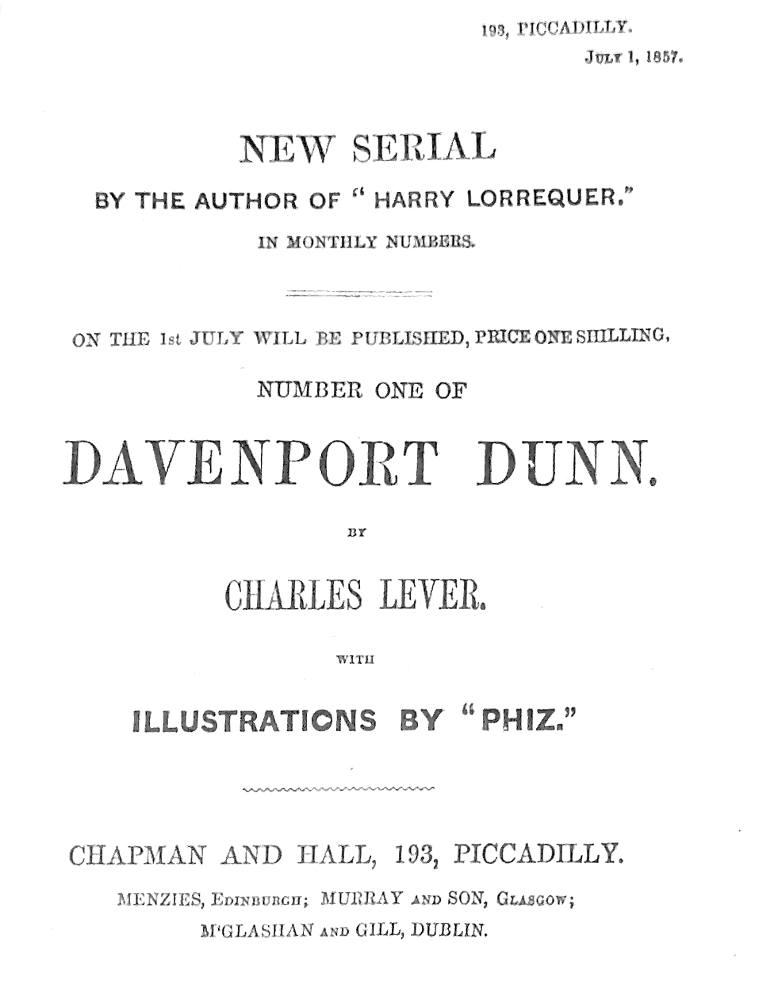

The Monthly Cover, No. II (August 1857) by Phiz (Hablot K. Browne), second serial number of Charles Lever's Davenport Dunn: The Man of The Day, 20.7 cm (6 ⅛ inches) high by 13.5 cm (5 ¼ inches) wide, vignetted. The monthly cover for the final, double number (Parts XXI & XXII), issued on 1 April 1859 at 2 shillings.
Scanned image, colour correction, sizing, caption, and commentary by Philip V. Allingham. [You may use this image without prior permission for any scholarly or educational purpose, as long as you (1) credit the person who scanned the image, and (2) link your document to this URL in a web document or cite the Victorian Web in a print one.] Click on the image to enlarge it.
Bibliographical Information
In the 1859 (first edition) single-volume edition, the pagination is identical to that which Chapman and Hall have used throughout the twenty-two monthly parts. The Table of Illustrations, which appeared in the final double number, shows the serial collector where precisely to insert the monthly illustrations, which always precede the text.
Davenport Dunn. The Man of the Day. By Charles Lever. London: Chapman and Hall, 193 Piccadilly. No. II. Price 1 s. The cover references three United Kingdom publishers affiliated with Chapman and Hall: Menzies in Edinburgh, Murray in Glasgow, and M'Glashan & Gill in Dublin. ["The right of translation is reserved."] 695 pages. Engraved frontispiece, vignette title-page, 42 plates by Phiz. (Four plates accompanied the final, double number). The original serial instalments contained far more than Lever's text; the "advertiser" included notice of forthcoming cheap editions of novels by Dickens and Lever, as well as patent medicine advertisements.
Commentary

The dualistic motif anticipates Phiz's construction of the 1859 cover for A Tale of Two Cities, which also involves two cities and two groups affected by the action of the story, although the cover does not directly allude to the Crimean War chapters. The falling hot-air balloons (indicative of the land-development scheme and the bank Dunn is propping up) suggest that investors in both London and Dublin (the cities to either side of the giant-headed Dunn) will suffer a fall, although nobody seems to be breaking his neck. In the scene to the right, a speeding locomotive (perhaps Dunn's special train) races towards industrial smokestacks while traversing a viaduct, whereas the buildings to the left are suggestive of the London skyline, with church spires and the dome of St. Paul's Cathedral. At the bottom is a vignette that the novelist never realizes: an Arab lies beside a dead camel, while another points toward a line of tropical palms in the distance. The identities of the two groups Phiz suggests by their clothing and postures: the wealthy English and Anglo-Irish male and female investors are to the left, joined by a magistrate in a long wig and several officers in uniform, and Irish bourgeoisie joined by an earl to the right, suggestive of the two social worlds in which Dunn moves and upon which he casts a long shadow. Phiz uses the blazing sun of noon behind his head to form a holy aura or halo, as if with his financial wizardry Dunn is the equivalent of a mediaeval saint. These details suggest that Charles Lever generally mapped out for Phiz the over-all trajectory of the story well before 1 July 1857 when the first instalment went on sale at the four publishers' offices. These designs are not mere "wrappers," but booklet "covers" printed on fairly stout paper, making each instalment a miniature paperback.
Working methods: Phiz and Horses
Reference
Lever, Charles. Davenport Dunn: The Man of The Day. Illustrated by "Phiz" (Hablot Knight Browne). London: Chapman and Hall, July 1857 through April 1859 with twenty-one instalments and twenty-two parts Image courtesy of Special Collections, The McPherson Library, University of Victoria, B. C., Canada. In the volume form, the novel was re-titled Davenport Dunn: A Man of Our Day (April 1859).
Last modified 27 July 2019